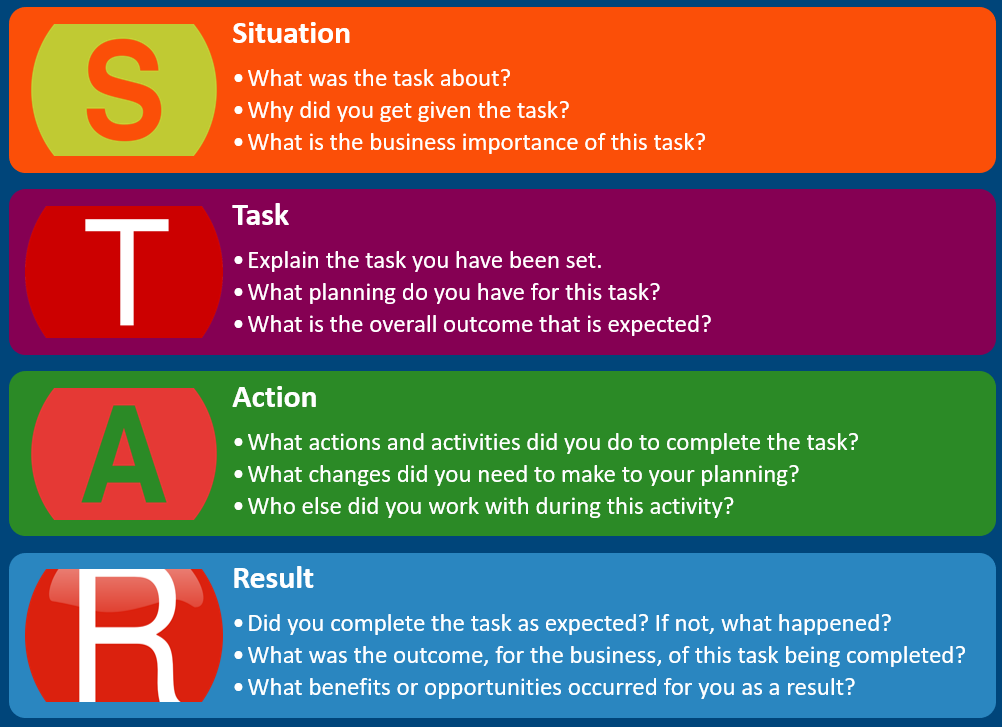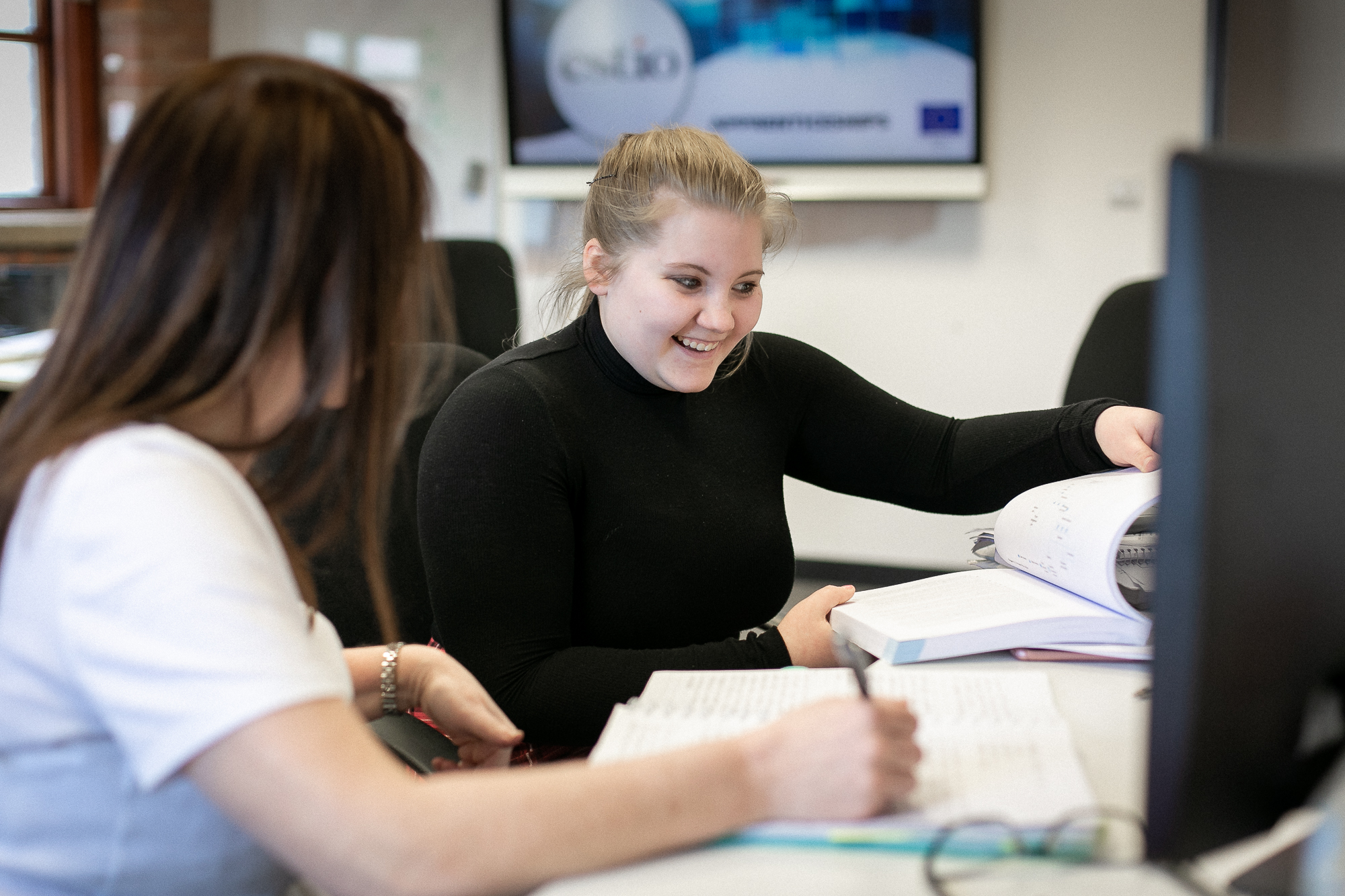STAR & Story
Knowing what your Portfolio will consist of and what competencies it is mapped against is a good start for planning your Portfolio work. After identifying your Portfolio piece ‘focus’, it is time to start thinking about how you will get the information and experience you have had across to the Assessor, in the clearest and most suitable approach.
Every Portfolio piece needs to tell a story. That story is a mix of explanations (i.e. content) and supporting evidence (i.e. images, etc). Together, the content and supporting evidence show the Assessor what you have been doing during the task or project and how you approached it. It is the story that helps the Assessor get the most out of your Portfolio and helps them prepare for your Professional Discussion; where they will ask you about your experiences and give you the opportunities to expand and add more depth and detail.
The best technique to get the story across in your Portfolio piece is to use the STAR model. This is an approach that is also good for your Professional Discussion too. You can find out more about your Professional Discussion assessment method, in the Professional Discussion section.

Producing a Portfolio piece of work can seem like a daunting task when you start, but there are techniques which you can use to help you. One of the best techniques available, is to think about the structure and content overview that your Portfolio will contain. The STAR (Situation, Task, Action, Research) model is a great tool to use, and it can be very powerful indeed.
One of the main features of the STAR model, is how it can help you think about breaking down a large task in to something small and more achievable. This brings in something else, called ‘Divide and Conquer’. The divide and conquer technique is a great life skill anyway, but it is about taking large (possibly un-manageable tasks) and breaking them in to small, focused, tasks. Tasks which are more achievable; and when those tasks are done, you will have completed to original (large) task.
There is another, great, advantage of using the STAR model to start work on your Portfolio piece. The STAR model is the format which EPAOs (End Point Assessment Organisations) want to see your work presented in as it makes it easy for the Assessor to see what you need them to see from your work. In addition, perfecting your use of the STAR model early will make life easier in your Professional Discussion too. That is because the Assessor wants to hear you answer their questions using the STAR model during the discussion too. To help structure your first use of the STAR model, there is a document/ framework to help.
To get started with the STAR Model, you can download the framework template by clicking the underlined link, or the image.
Once you have downloaded the file, you can start filling in the two empty columns by responding to the questions and focus of each row in the table.
Questions – You can expand on the part in STAR by asking yourself questions which add additional understanding and depth to that element. Good questions to ask make use of the key question formats 1) What, 2) Why, 3) How, 4) Who, and 5) Benefit? Using these will help you identify the additional supporting detail.
Brief Details/ Overview – In this column, for each row, you can put your answers to the questions. The answers do not need to be fully detailed or expanded upon, but should be sufficient to allow you the ability to refer back to them later and still understand what you were saying. Allowing you to easily ‘pick up where you left off’ so you can continue building your Portfolio piece. These answers will also start to identify the structure and order in which you put content in your work.
Evidence – As you write your Portfolio content, you need to be thinking about how you can back-up and support what you are saying in your content. This is where evidence plays a key role in the Portfolio. Every-time you say “I did”, you need to support it somehow. Evidence should be able to ‘show what you have said’ and give it real-world back-up. It is much better to include more evidence than is required, rather than try to add to the evidence later. You can see more support on evidence gathering in the Gathering Evidence section of the site.
The start of your story
The start of your story is about setting the scene for the Assessor. In this section, you will detail the Situation you were in, and the Task that you were given, to provide the background to the task or activity you are going to cover in the rest of your Portfolio piece.
Using the questions, your answers, and the evidence from the framework template will give you a detail and very powerful start to help the Assessor get a good understanding of what you will be covering and what you did to get this workplace activity started.
This section will cover the whole of the Situation (S) and Task (T) from the STAR model.
The middle of your story
The middle part of your Portfolio is, most-likely, going to be the biggest part of your work. In this section you will explain every Action that you took during your workplace activity or task; including the use of evidence to support what you are saying. Remember the phrase “Say it, show it” to make sure you evidence everything you say you did. This is extremely important.
To help add depth and meaning to the content in this section of the Portfolio piece, you will expand on the actions to include:
- What you did
- as discussed above,
- How you did it
- as above, but detailed steps and evidence included, and
- With Whom you did it
- who else did you communicate and work with during this project?
- why did you report to or work with that person/ those individuals?
- Whay input did they have to your work?
All of this helps the Assesor to get the best possible picture of your activities, your approach to that work, and also who else (and how) you worked with. This allows the Assessor to see you work as part of a team and not just on your own.
This section will cover the whole of the Action (A) from the STAR model.
The end of your story
When concluding your story and Portfolio piece, you should be bringing all of the threads of the content together to form the final outcomes. This section of your Portfolio piece looks at the Results (R) of the STAR model.
The questions, and content, around this part all focus on what the outcomes of the actions and tasks that you completed. Thinking about the benefit, on you and the business, of the activity. You can also talk about what happened after the project or task was complete and what came next.
This section will cover the whole of the Result (R) from the STAR model.
The encore to your story
After you have completed your draft of the Portfolio piece, it can be given to your colleagues or line manager for feedback before being submitted to your trainer for feedback and supportive comment. The next draft will respond to that and you will submit it again.
Once you and your trainer agree that the Portfolio piece is completed, it will be ‘signed-off’ on ELMS and you can move your focus to other pieces of work. That doesn’t mean it is done and dusted though.
As you progress towards ‘Gateway’ (see your standard specific page for more information about this), you will be aksed to look back your Portfolio pieces and add in any additional detail or content you would like to. This opportunity allows you, and your trainer, to make sure that the best possible version of your Portfolio is submitted to the Assessor. Changes and additions at this point can includemore recent activites that relate back to the individual project or task you have discussed. Examples include; other projects whihc are similar or more advanced due to showing your abilities, promotion, workplace (or industry) recognition, pay rises, and much more).
Including the additional content, allows the Assessor to get the most up-to-date information and detail. It can help to push towards higher outcomes on occassion.
Now that you have your detailed content and information for the Portfolio piece, you now need to start putting together your ‘story’. The story is about how you cover the detail and content, telling the Assessor what you did, supporting it with evidence, and making sure the Assessor can imagine what happened; almost as if they were there watching you complete the task or activity. Bringing all of the content, evidence, and structure together properly will make this a really powerful Portfolio piece.
Every Portfolio piece’s story will have two key central pillars: 1) STAR Model, and 2) Start, Middle, and End. If you can remember back to GCSE English lessons, and how to structure a story, that will help you here.
Something that often helps learners as a reminder when writing their Portfolio story, is to imagine they are telling a relative (one that doesn’t understand their job role) about something they have done at work. Much like answering a friend question ‘what did you do at work today?” If you could give your completed Portfolio piece to somebody in a different line of work, and they can ask you questions about it afterwards, that is a good portfolio piece. The Assessor, somebody who knows your industry and the work within it, but not your job or employer, will ask you questions to lead discussions around your skills, abilities, and experiences in the same way. They will just be a little more focused.
Something that is VERY IMPORTANT when putting your story together, is the format in which you will be presenting it. As you, the apprentice, lead and own the Portfolio process, you can pick any format and presentation approach you like – as long as it is sensible and still conveys the content as expected. To look at more about the types of presentation format and structure you can use in your Portfolio piece (i.e. document, report, presentation, video, locally hosted website, and more) have a look at the Format & Structure section.
Size & Focus
Every standard has a different ‘size’ for its Portfolio. The ‘focus’ for a piece is agreed between yourself, your employer and your trainer. Look at how to lead on this part of the process
STAR & Story
Everybody likes a story, and putting your Portfolio work in the best possible format – using STAR – helps you to get the best version across to the Assessor in a content-rich delivery
Format & Structure
Portfolio pieces can be presented and formatted in any approach that is suitable for you. See what this means and how you can make your Portfolio even more personal
Gathering Evidence
Evidence can come in many forms and is key to supporting your Portfolio content. Investigate how you can gather ‘real-time’ evidence and how to make the most of it
Writing Skills & Styles
You have your focus, your evidence, and your structure. How can you make the most of your writing to make sure you get the Portfolio you want? Have a look here


